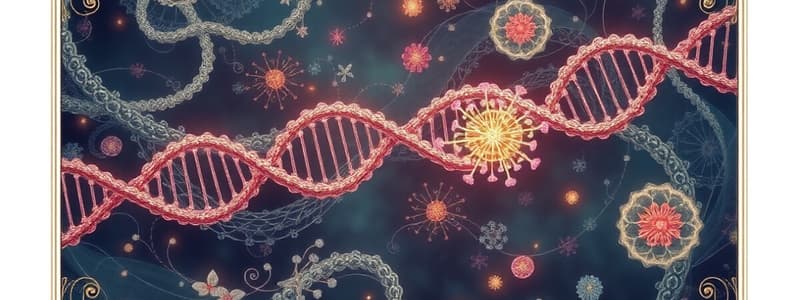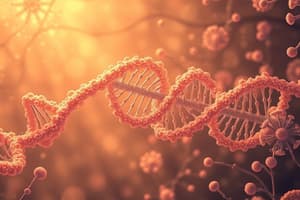Podcast
Questions and Answers
What are regulons characterized by?
What are regulons characterized by?
- Sets of genes responding to the same regulatory system (correct)
- Multiple genes controlled by different regulatory elements
- Genes that are permanently expressed
- A single gene responding to multiple signals
Which regulatory protein is involved in the SOS response by cleaving lexA?
Which regulatory protein is involved in the SOS response by cleaving lexA?
- RNA polymerase
- repressor protein
- sigma factor
- recA (correct)
What does catabolite repression primarily do?
What does catabolite repression primarily do?
- Increases the transcription of carbon source operons
- Enhances the activity of all operons
- Activates stress response genes
- Shuts down metabolic pathways when glucose is present (correct)
What role does the sigma factor play in bacterial transcription?
What role does the sigma factor play in bacterial transcription?
When is the SOS response typically activated?
When is the SOS response typically activated?
What is the function of lexA in the SOS response?
What is the function of lexA in the SOS response?
Which sigma factor is commonly associated with heat response in bacteria?
Which sigma factor is commonly associated with heat response in bacteria?
What happens once the damage has been repaired in the SOS response?
What happens once the damage has been repaired in the SOS response?
What is the primary function of quorum sensing in microbial communication?
What is the primary function of quorum sensing in microbial communication?
In the context of quorum sensing, what role do autoinducer molecules play?
In the context of quorum sensing, what role do autoinducer molecules play?
How does the Hawaiian bobtail squid utilize quorum sensing?
How does the Hawaiian bobtail squid utilize quorum sensing?
What distinguishes the V. fischeri cells when they are in the light organ of the squid?
What distinguishes the V. fischeri cells when they are in the light organ of the squid?
Which of the following is NOT a characteristic of quorum sensing?
Which of the following is NOT a characteristic of quorum sensing?
What is the primary function of the operator site in DNA with regard to transcription?
What is the primary function of the operator site in DNA with regard to transcription?
Which type of enzymes is primarily controlled by repression during negative control?
Which type of enzymes is primarily controlled by repression during negative control?
How does induction affect transcription?
How does induction affect transcription?
What is the role of co-repressor in repression?
What is the role of co-repressor in repression?
What mechanism is involved in the positive control of transcription?
What mechanism is involved in the positive control of transcription?
What is typically the result when a signal inhibits transcription through repression?
What is typically the result when a signal inhibits transcription through repression?
In the context of negative control, what does 'derepression' mean?
In the context of negative control, what does 'derepression' mean?
Which of the following describes the role of the allosteric protein in the positive control mechanism?
Which of the following describes the role of the allosteric protein in the positive control mechanism?
What does a high level of glucose detection indicate about its transport?
What does a high level of glucose detection indicate about its transport?
What role does tryptophan play in the tryptophan synthesis operon?
What role does tryptophan play in the tryptophan synthesis operon?
In the context of the tryptophan synthesis operon, what is the significance of negative control?
In the context of the tryptophan synthesis operon, what is the significance of negative control?
Which mechanism describes how rho-dependent termination occurs in bacterial transcription?
Which mechanism describes how rho-dependent termination occurs in bacterial transcription?
What is the key characteristic of rho-independent termination?
What is the key characteristic of rho-independent termination?
Which structural genes in the tryptophan operon are necessary for synthesizing tryptophan?
Which structural genes in the tryptophan operon are necessary for synthesizing tryptophan?
How does attenuation affect transcription regulation?
How does attenuation affect transcription regulation?
What is the role of RNA polymerase during transcription in bacteria?
What is the role of RNA polymerase during transcription in bacteria?
What effect does phosphorylated CheY have on flagellar movement?
What effect does phosphorylated CheY have on flagellar movement?
What happens in the absence of attractants in terms of CheA activity?
What happens in the absence of attractants in terms of CheA activity?
Which protein is responsible for demethylation of MCPs?
Which protein is responsible for demethylation of MCPs?
What is the role of MCPs in the adaptation response?
What is the role of MCPs in the adaptation response?
What happens to the sensitivity of MCPs when moving away from a repellent?
What happens to the sensitivity of MCPs when moving away from a repellent?
How does CheZ contribute to the system after tumbling occurs?
How does CheZ contribute to the system after tumbling occurs?
What is a feedback loop in the context of MCPs and their adaptation?
What is a feedback loop in the context of MCPs and their adaptation?
What determines the direction of flagellar rotation in a 'bad' situation?
What determines the direction of flagellar rotation in a 'bad' situation?
Which of the following statements about Che proteins is true?
Which of the following statements about Che proteins is true?
What is the primary function of constitutive genes?
What is the primary function of constitutive genes?
How do covalent modifications regulate protein activity?
How do covalent modifications regulate protein activity?
What does allosteric regulation involve?
What does allosteric regulation involve?
Why is energy conservation important in regulating transcription?
Why is energy conservation important in regulating transcription?
What are inducible genes characterized by?
What are inducible genes characterized by?
Which of the following is a key characteristic of the Operon?
Which of the following is a key characteristic of the Operon?
What role do key cellular enzymes play in metabolism?
What role do key cellular enzymes play in metabolism?
What is the impact of changes in environmental conditions on gene regulation?
What is the impact of changes in environmental conditions on gene regulation?
Which is NOT a method of regulating protein activity?
Which is NOT a method of regulating protein activity?
What is a potential consequence of not turning off certain cellular processes?
What is a potential consequence of not turning off certain cellular processes?
Flashcards
DNA Replication
DNA Replication
The process where DNA is copied to produce identical DNA molecules, ensuring that each new cell receives a complete set of genetic instructions.
Transcription
Transcription
The process where DNA is used as a template to create messenger RNA (mRNA), which carries the genetic code to ribosomes for protein synthesis.
Translation
Translation
The process where the genetic information carried by mRNA is used to assemble amino acids into proteins at ribosomes.
Downregulation
Downregulation
Signup and view all the flashcards
Constitutive Genes
Constitutive Genes
Signup and view all the flashcards
Inducible Genes
Inducible Genes
Signup and view all the flashcards
Operon
Operon
Signup and view all the flashcards
Post-translational Modification
Post-translational Modification
Signup and view all the flashcards
Allosteric Regulation
Allosteric Regulation
Signup and view all the flashcards
Transcriptional Regulation
Transcriptional Regulation
Signup and view all the flashcards
Quorum Sensing
Quorum Sensing
Signup and view all the flashcards
Autoinducer Molecules
Autoinducer Molecules
Signup and view all the flashcards
Regulation of Gene Expression in Quorum Sensing
Regulation of Gene Expression in Quorum Sensing
Signup and view all the flashcards
Hawaiian Bobtail Squid Bioluminescence
Hawaiian Bobtail Squid Bioluminescence
Signup and view all the flashcards
Lux System
Lux System
Signup and view all the flashcards
Negative control of transcription
Negative control of transcription
Signup and view all the flashcards
Inducer
Inducer
Signup and view all the flashcards
Repression
Repression
Signup and view all the flashcards
Repressor protein
Repressor protein
Signup and view all the flashcards
Positive control of transcription
Positive control of transcription
Signup and view all the flashcards
Activator protein
Activator protein
Signup and view all the flashcards
Positive control
Positive control
Signup and view all the flashcards
Induction
Induction
Signup and view all the flashcards
Negative Control
Negative Control
Signup and view all the flashcards
Anabolic Operon (Negative Control)
Anabolic Operon (Negative Control)
Signup and view all the flashcards
Attenuation
Attenuation
Signup and view all the flashcards
Rho protein (rho-dependent termination)
Rho protein (rho-dependent termination)
Signup and view all the flashcards
Rho-independent termination
Rho-independent termination
Signup and view all the flashcards
Structural genes (trp operon)
Structural genes (trp operon)
Signup and view all the flashcards
trpL region (Tryptophan Operon)
trpL region (Tryptophan Operon)
Signup and view all the flashcards
What are regulons?
What are regulons?
Signup and view all the flashcards
What is catabolite repression?
What is catabolite repression?
Signup and view all the flashcards
What is the SOS response?
What is the SOS response?
Signup and view all the flashcards
What is LexA?
What is LexA?
Signup and view all the flashcards
What is RecA?
What is RecA?
Signup and view all the flashcards
How do sigma factors influence gene expression?
How do sigma factors influence gene expression?
Signup and view all the flashcards
What is a repressor protein?
What is a repressor protein?
Signup and view all the flashcards
What is sigma 70?
What is sigma 70?
Signup and view all the flashcards
What causes bacterial tumbling?
What causes bacterial tumbling?
Signup and view all the flashcards
How does phosphorylated CheY affect bacterial movement?
How does phosphorylated CheY affect bacterial movement?
Signup and view all the flashcards
What are MCPs and what do they do?
What are MCPs and what do they do?
Signup and view all the flashcards
How does methylation of MCPs affect chemotaxis?
How does methylation of MCPs affect chemotaxis?
Signup and view all the flashcards
What is CheA and what happens when it becomes phosphorylated?
What is CheA and what happens when it becomes phosphorylated?
Signup and view all the flashcards
What is CheB and what is its role in chemotaxis?
What is CheB and what is its role in chemotaxis?
Signup and view all the flashcards
What is CheZ and how does it affect bacterial movement?
What is CheZ and how does it affect bacterial movement?
Signup and view all the flashcards
What is adaptation in chemotaxis?
What is adaptation in chemotaxis?
Signup and view all the flashcards
How do attractants affect the phosphorylation of CheA?
How do attractants affect the phosphorylation of CheA?
Signup and view all the flashcards
How do repellents affect the phosphorylation of CheA?
How do repellents affect the phosphorylation of CheA?
Signup and view all the flashcards
Study Notes
DNA Regulation
- DNA must be copied to create new cells
- Transcription converts DNA into working copies for enzymes and structural proteins
- Not all processes run simultaneously; cell regulation prevents unnecessary functions and cell death
Environmental Conditions
- Environmental factors like nutrient availability and competition affect gene regulation
- Cells respond to changes in conditions through specific responses
- Substrate specificity and metabolism are regulated by environment
Key Cellular Enzymes
- Constitutive enzymes are always active, preventing cell death
- Examples include those involved in TCA cycle and ATP synthesis
- Constitutive genes are housekeeping genes, always expressed
Covalent Modification
- Enzymes' activity is altered by adding or modifying amino acids
- Methods include phosphorylation, acetylation, methylation, and glycosylation
- Conformation changes affect active sites and influence enzyme activity
Allosteric Regulation
- Small molecules interact with an allosteric site, changing enzyme conformation
- This might lead to activation (better fit to the substrate) or inhibition (worse fit) of the active site
- Results from an interaction that is not directly at the active site
Regulating Transcription
- Energy is conserved through controlling enzyme synthesis to prevent transcription of unnecessary genes
- The operon, a collection of structural and regulatory elements, controls structural gene expression.
Positive Control
- A regulatory protein will enhance RNA polymerase binding to the promoter, increasing transcription.
- RNA polymerase and sigma factor don't bind, activator proteins will help bind
Negative Control
- Transcription is inhibited by regulatory proteins that block RNA polymerase processes
- Two types: repression (stopping transcription already in progress) and induction (preventing transcription altogether).
Operon Structure and Control
- Structural genes are grouped together under one regulatory system.
- Promoter: DNA sequence where RNA polymerase binds.
- Operator: DNA sequence where a repressor protein can bind to prevent transcription.
Positive and Negative Control Regulation
- Positive control uses a regulatory protein to enhance the binding of RNA polymerase to the promoter for increased transcription expression.
- Negative control utilizes a regulatory protein to prevent RNA polymerase from binding to the promoter, decreasing transcription
Genes and Operons
- The lac operon regulates lactose metabolism, switching on expression when glucose is depleted.
- Lactose is better to use than glucose (easier/cheaper) as an energy source
- Use of lactose expression occurs when glucose is not available, thus transcription occurs to get it in and break it down
Attenuation
- Transcription can be stopped before termination (transcription is halted before it is completed)
- Rho-dependent and rho-independent mechanisms are used to end transcription
- Ribosomes' presence impacts transcription to ensure genes will only be expressed when required
Tryptophan Synthesizing Regulation
- Genes for tryptophan synthesis are regulated, preventing unnecessary production
- Attenuation controls tryptophan production based on current levels.
Positive and Negative Control of Transcription
- Transcription can be either enhanced or suppressed by effector molecules (a chemical/signal) binding to DNA binding proteins.
Quorum Sensing
- Bacteria communicate with each other through chemical signals, quorum sensing, to coordinate population density-dependent actions.
- Cells release molecules based on population density to regulate gene expression
Hawaiian Bobtail Squid Bioluminescence
- Bioluminescence (light production) is regulated to conserve energy
- N-acyl-homoserine lactone (AHL) regulates it in specific amounts.
No Quorum
- Lux genes, when they function poorly, do not produce as much light
- Enzyme (luxI) is present. It produces AHL during the day.
- The activator protein isn't present thus light is not produced/ made
Chemotaxis
- Bacteria's response to chemical gradients is chemotaxis.
- They use chemotaxis proteins to sense chemical gradients to control how they respond to and move toward or away from attractant and repellents
Adaptation
- Chemotaxis adaptation regulates sensitivity to attractants and repellents based on methylation of certain proteins.
- Methylation/demethylation changes the sensitivity to attractants/repellents
Two-component regulatory systems
- The system includes a sensor kinase, which detects stimuli
- Histidine protein kinases are sensor kinases which add phosphate groups to proteins (phosphate group is a signal)
- The response regulators regulate transcription based on the signal from the sensory kinase.
Two-Component regulatory systems (additional details)
- Stimulus outside the cell is detected by sensor proteins (sensor kinase) (HPK)
- Phosphate group is transferred to the regulator (response) (RR)
- The regulator controls the gene transcription response to stimulus (short lived response)
- Re-establishing the original state of the response is crucial for regulating the process
- Examples include crown gall tumors, and plant bacterial interactions
Other Considerations
- alternative sigma factors control transcription when the default sigma factor isn't suitable (for instance, in heat, stress, etc.)
- Regulons are sets of genes coordinately controlled by a single regulatory system for coordinated expression/ action
Studying That Suits You
Use AI to generate personalized quizzes and flashcards to suit your learning preferences.




